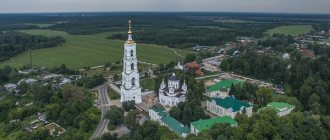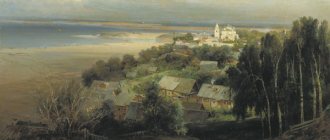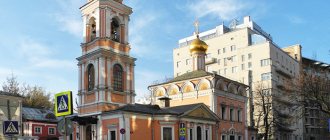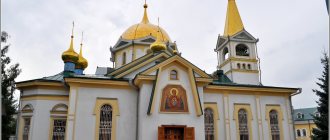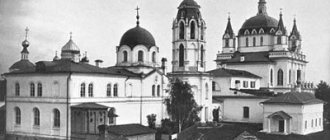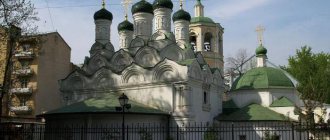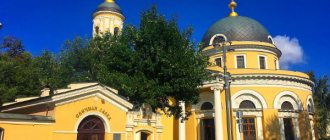In the north of the Moscow region, the Nikolo-Peshnoshsky Monastery, one of the oldest in our area, has survived to this day. It was founded in 1361 by the holy Venerable Methodius of Peshnosh, a disciple of the holy Venerable Sergius of Radonezh. Now the monastery is being restored.
♦ On the topic: One-day excursions from Moscow: cities, estates, temples and monasteries
Nikolo-Peshnoshsky Monastery, pre-revolutionary photograph
Historical events
The Nikolo-Peshnoshsky Monastery (Dmitrovsky district) was founded by a monk, a student and follower of Sergius of Radonezh in the 14th century. The monk Methodius, in search of a place for a solitary pilgrimage, settled in a small cell built by the river, about a kilometer from the modern location of the monastery.
The hermit became famous throughout the area for his holy life, people flocked to him for help and consolation, and gradually those thirsting for monastic life began to stay and live with Methodius. There was a need to build a church. Sergius himself indicated the place for it, thereby choosing the location of the future monastery near a tributary of the Peshnoshka River.
The first wooden church was consecrated in honor of St. Nicholas in 1361, which was the reason for the name of the monastery.
There is another version of the name of the monastery, which suggests that it came from a combination of the words walking burden, since the Monk Methodius carried logs on foot across the river during the construction of the church. The fame of the monastery continued to grow, attracting numerous pilgrims, donors and benefactors, which led to the prosperity and wealth of the monastery.
Among the main benefactors, one can especially highlight the sons and descendants of the most famous princely families and royal persons. From the middle of the 15th century, the monastery actively traded in surplus stocks of grown bread, which made it possible to build the first stone cathedral.
At the end of the 16th century, a severe fire destroyed almost all the monastery buildings. And in troubled times at the beginning of the 17th century, the newly built monastery was burned and taken by the Poles, despite the selfless resistance of the monks. During the defense of the monastery from the enemy sword, 2 hieromonks, 2 priests, 1 hierodeacon, 6 schema-monks and 37 laborers were killed.
Under Tsar Mikhail Romanov, the monastery was revived again. By the middle of the century there were already 3 stone churches with a bell tower, refectories with cellar chambers, and other outbuildings made of stone and wood. Repeatedly throughout the history of the monastery, it was visited by royalty, who provided rich contributions for the construction of churches.
In the middle of the 18th century, a church was erected over the grave of the reverend founder of the monastery, Methodius, in honor of his teacher Sergius of Radonezh, the walls with towers were strengthened, and a new road was paved. From this time on, the former heyday of the monastery ended and a period of desolation began, which led to the closure of the monastery in 64 due to ongoing secularization reforms in the country.
But after 1.5 years, the monastery was opened at the request of Mikhail Verevkin, a local landowner, who was joined by merchants from Dmitrov Ivan Sychev and Ivan Tolchenov. The renewed monastery began to submit to the Pereyaslav diocese, and by the end of the century before last it transferred to the Moscow Metropolis.
During this period, its new blossoming begins, the monastery is rebuilt and expanded, taking on its final appearance.
In 1928, the monastery was closed, all buildings were transferred to the Dmitrov Museum of Local History, which made it possible to preserve the main church values, but not for long, since the directors were soon repressed and the museum was closed. For a long time after this, the entire territory was occupied by a Home for the Invalids, and then it was transferred to a psychoneurological boarding school, where it existed until 2013.
The Jubilee Orthodox Council of the church glorified in 2000 4 new martyrs who emerged from the walls of the monastery:
- Gerasim Mochalov;
- Josafa Shakhov;
- Nikolai Saltykov;
- Aristarkha Zaglodin-Kokorev.
Story about visiting the monastery
I’ve wanted to come here for a long time, but somehow things didn’t work out. And the stories on the Internet were somewhat frightening. And so, some time ago, Michael and I finally got to this place. And they were amazed by this monastery.
There is a good road from Rogachev towards the monastery, located in the village of Lugovoi. All around is a flat lowland covered with swampy forests. In some places, the view opens up to huge fields stretching to the very horizon. Then, the famous Alley of Elms begins. They say that it was badly damaged during the Moscow hurricane of 1998. Even in winter it amazes the imagination. I think it's even more beautiful here in the summer.
Alley of Elms (Ekaterininskaya)
Soon the monastery itself appears in the distance. He makes a very strong impression.
View of the Nikolo-Peshnoshsky Monastery
We drove up to the monastery and stopped in bewilderment: from the monastery to the ancient building located opposite the entrance to the monastery, boarding school patients walked back and forth, and screams were heard from behind the walls of the monastery. We found out from two pleasant women standing at the bus stop waiting for the bus that entry through the main entrance (Spasskaya Tower) is only with passes and for the sick. To get to the monastery, you need to go a little further, turn the corner and go through the gate in the fortress wall. We followed their advice.
Abandoned house next to the monastery
Nikolo-Peshnoshsky Monastery
Some fences and buildings of the monastery courtyard stretched along the monastery. I began to doubt whether we were going the right way. However, they soon discovered a half-open gate made of corrugated sheets, on which hung a sign with a story about the founding of the monastery. So we got it right.
Information about the monastery
But behind the gate there was a new obstacle: right under the monastery walls a huge herd of cows was grazing, among which I noticed several bulls, and horses were walking in the levada. Several shepherds kept an eye on them. We walked through them with caution, although the shepherd woman assured us that we would not be gored or trampled. But, you know, it’s somehow scary anyway
